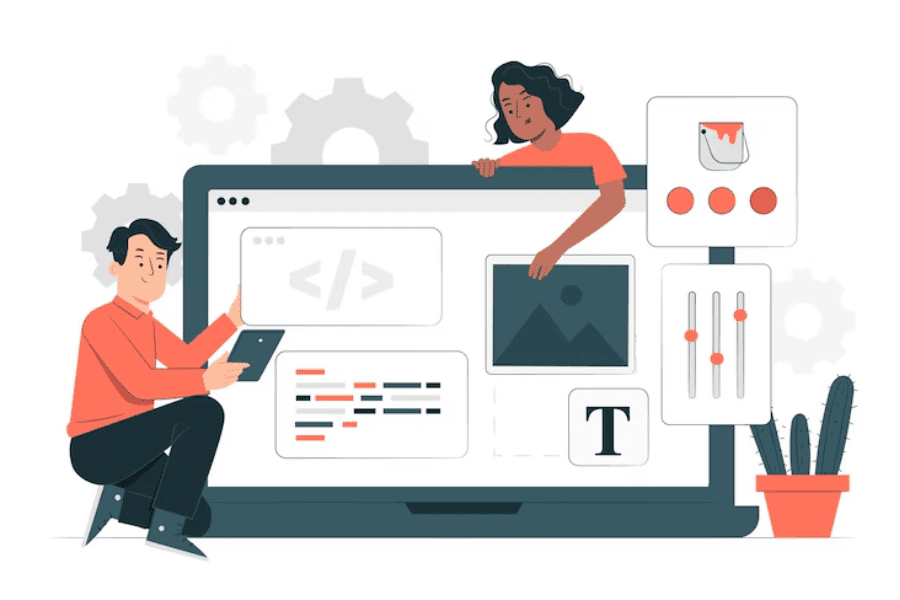In the digital era, a compelling website design is the cornerstone of online success for businesses in Ohio. Whether you’re a startup or an established enterprise, your website serves as the virtual storefront, representing your brand and engaging potential customers. Here, we’ll delve into ten essential tips for creating a captivating website design for Ohio market.
The Importance of Website Design:
In today’s digital landscape, where online presence reigns supreme, the significance of website design cannot be overstated. Here’s a concise overview highlighting five key reasons why investing in exceptional website design is paramount:
1.First Impressions Matter:
Your website is often the first point of contact between your business and potential customers. A well-designed website instantly conveys professionalism and credibility, making a positive impression that can significantly impact visitors’ perceptions of your brand.
2.Reflects Brand Identity:
Your website serves as a digital reflection of your brand’s personality, values, and mission. Through strategic design elements such as color schemes, typography, and imagery, you can effectively communicate your brand identity and differentiate yourself from competitors.
3.Enhances User Experience:
User experience (UX) is a critical factor in determining the success of your website. A thoughtfully designed interface with intuitive navigation, clear content organization, and seamless functionality ensures that visitors can easily find what they’re looking for, leading to higher engagement and conversion rates.
4.Builds Trust and Credibility:
A professionally designed website instills trust and confidence in your audience. By presenting a polished and cohesive online presence, you demonstrate to visitors that you are reputable, reliable, and committed to delivering a high-quality experience.
5.Drives Business Growth:
Ultimately, the goal of your website is to drive tangible business results. Whether it’s generating leads, increasing sales, or building brand awareness, an effective website design plays a pivotal role in achieving these objectives. A visually appealing and user-friendly website attracts and retains customers, ultimately contributing to your bottom line.
Understanding the Target Audience:
Before diving into the design process, it is crucial to thoroughly understand your target audience. Conducting market research and analyzing your target demographic will provide valuable insights into their preferences, needs, and expectations. Understanding your audience will help you make informed design choices, such as selecting appropriate colors, typography, and visual elements. By tailoring your website design to your target audience, you can create a captivating user experience that resonates with your visitors and drives them to take desired actions.
Choosing the Right Color Scheme and Typography:
The color scheme and typography of your website play a crucial role in shaping its visual identity and conveying your brand message effectively. Thoughtful selection of colors and fonts can enhance readability, evoke emotions, and create a memorable user experience.
1. Color Scheme:
1.Reflect Brand Personality:
Choose colors that align with your brand’s personality and values. Consider the emotions you want to evoke in your audience.
2.Ensure Accessibility:
Opt for a color palette that ensures readability for all users, including those with visual impairments. Use contrast ratios to ensure sufficient distinction between text and background colors.
2. Typography:
1.Emphasize Readability:
Select fonts that are easy to read across different screen sizes and resolutions. Prioritize readability over elaborate design.
2.Maintain Consistency:
Use a limited number of font styles throughout your website to maintain visual consistency. Pair fonts wisely to create contrast and hierarchy without sacrificing cohesion.
By carefully choosing the right color scheme and typography, you can create a visually appealing website that effectively communicates your brand identity and engages your audience.
Creating a User-Friendly Navigation:
A user-friendly navigation system is essential for guiding visitors through your website and helping them find the information they need efficiently. By designing intuitive navigation, you enhance the user experience and encourage exploration of your website’s content.
1. Logical Structure:
1.Organize Content:
Group related content logically and structure it hierarchically. Ensure that visitors can easily navigate between main categories and subpages.
2.Clear Labels:
Use descriptive and concise labels for navigation menu items to communicate the content they lead to effectively.
2. Intuitive Design:
1.Predictable Layout:
Maintain consistency in the placement and appearance of navigation elements across your website. Users should easily recognize and locate the navigation menu.
2.Minimize Clutter:
Avoid overcrowding the navigation menu with too many options. Prioritize the most important pages and features to streamline the user journey.
By creating a user-friendly navigation system, you empower visitors to explore your website with ease, enhancing their overall satisfaction and engagement.
Incorporating Responsive Design for Mobile Devices:
With the increasing prevalence of mobile devices, it’s imperative to ensure that your website delivers a seamless experience across various screen sizes and orientations. Responsive design allows your website to adapt dynamically to different devices, optimizing usability and engagement for mobile users.
1. Flexible Layouts:
1.Adaptive Scaling:
Design layouts that automatically adjust to accommodate different screen sizes and resolutions. Ensure that content remains accessible and readable without requiring horizontal scrolling.
2.Touch-Friendly Interactions:
Optimize interactive elements such as buttons and menus for touch input. Increase tap targets and spacing to prevent accidental clicks.
2. Performance Optimization:
1. Efficient Loading:
Prioritize content loading and rendering based on device capabilities to minimize latency and improve performance. Serve appropriately sized images and resources to reduce bandwidth consumption.
2. Optimized User Experience:
Tailor the user experience to the context of mobile usage, such as on-the-go access and limited screen space. Simplify navigation and prioritize key content for mobile users.
By incorporating responsive design principles, you can ensure that your website delivers a consistent and engaging experience across all devices, maximizing accessibility and user satisfaction.
Optimizing Page Load Speed:
Page load speed is a critical factor that directly impacts user experience, search engine rankings, and conversion rates. By optimizing your website’s performance, you can reduce bounce rates, improve retention, and enhance overall satisfaction for visitors.
1. Image Optimization:
1. Compression:
Compress images to reduce file size without compromising quality. Use formats such as JPEG or WebP for photographs and PNG for graphics with transparency.
2.Lazy Loading:
Implement lazy loading techniques to defer the loading of off-screen images until they are needed, reducing initial page load times.
2. Minimizing HTTP Requests:
1.Combine Files:
Minimize the number of separate requests by combining CSS and JavaScript files. Reduce the overall file size and improve loading efficiency.
2. Asynchronous Loading:
Load non-essential resources asynchronously to prevent blocking the rendering of critical content. Prioritize above-the-fold content for initial loading.
By implementing strategies to optimize page load speed, you can create a more responsive and user-friendly website that keeps visitors engaged and satisfied.
Conclusion
Crafting a stunning website design in Ohio requires a strategic approach that prioritizes user experience, aesthetics, and brand identity. By implementing the ten tips outlined above, businesses can create a compelling online presence that resonates with their target audience and drives meaningful results.
For expert web design services tailored to Ohio businesses, contact Be Found Next at 440-670-8100 or email info@befoundnext.com. Let us help you elevate your online presence and achieve your digital goals.

